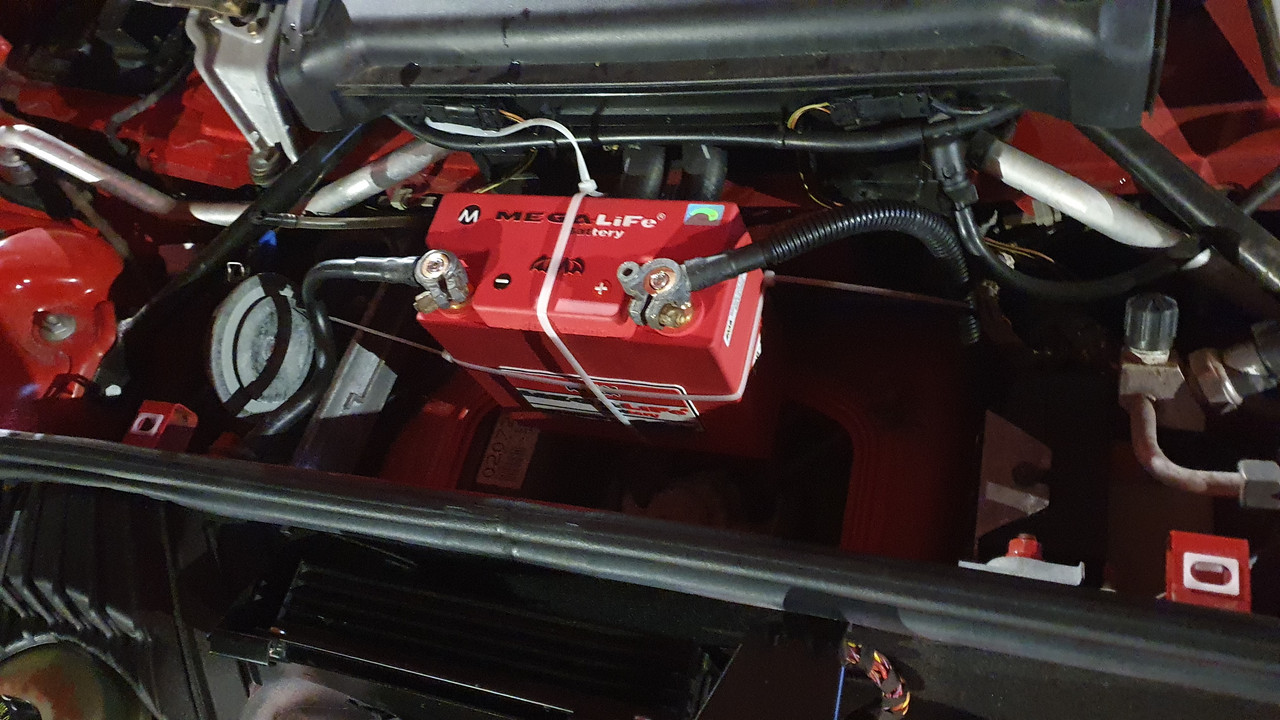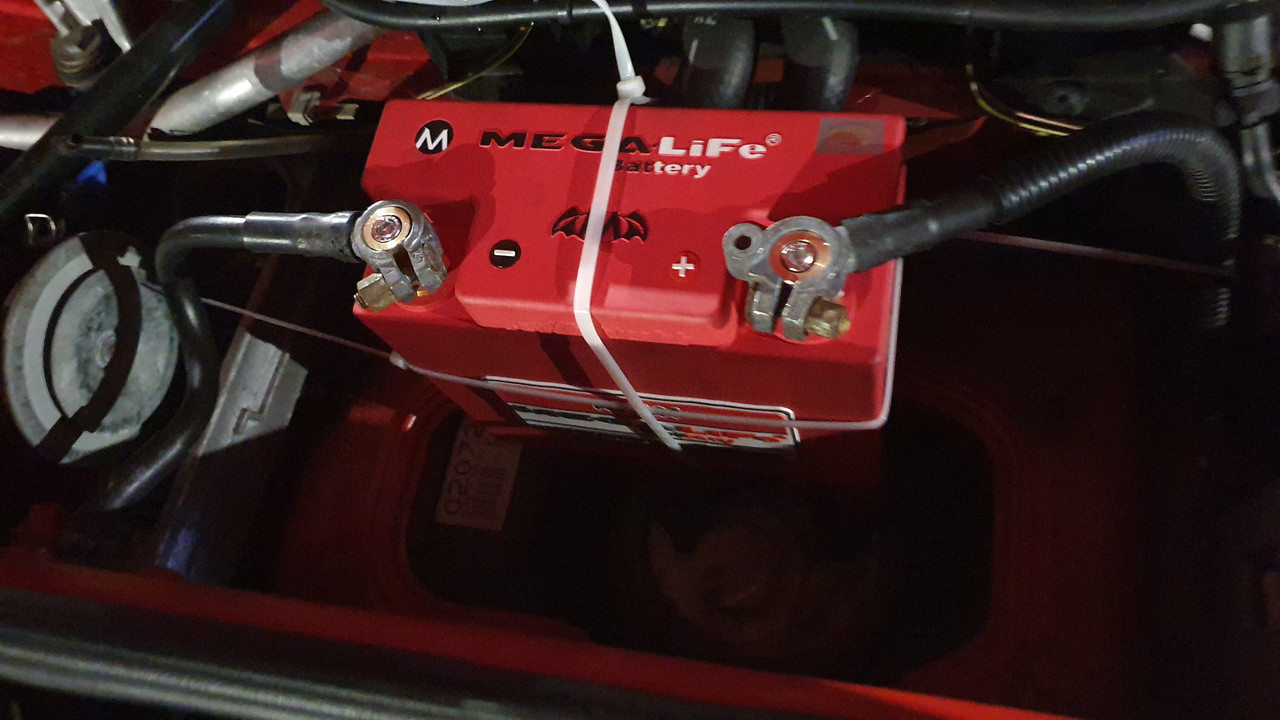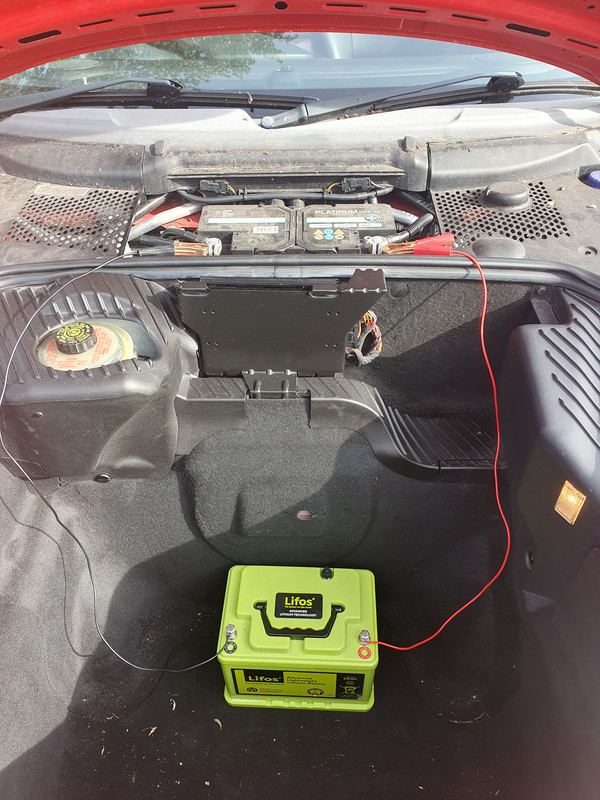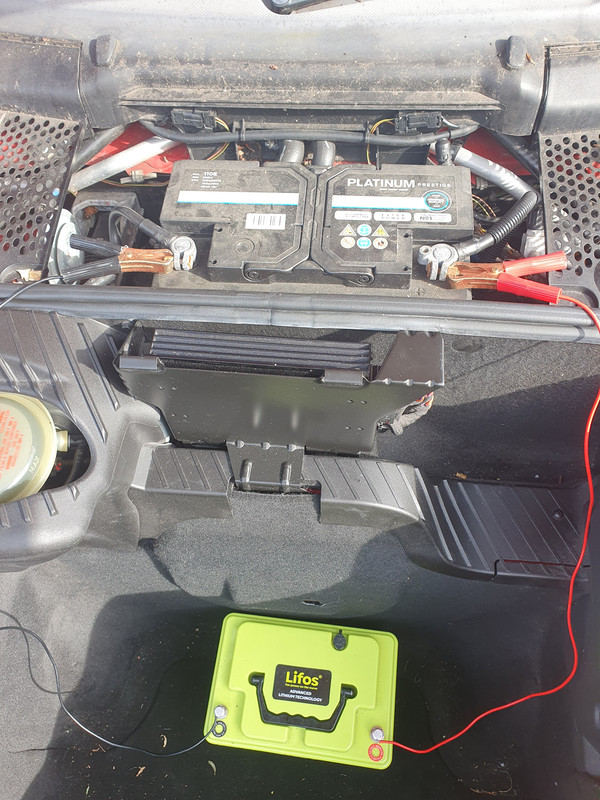LiFePo4 leisure battery to maintain Car Battery in situ
Discussion
So I've been asked to explain what's going on here and thought I'd start a new thread for this. So here it is...
Background
I started a little foray into the world of camper vans and ended up with some relatively beefy LiFePo4 leisure batteries but I dont really do any camping so these are basically surplus to requirements. I got to thinking about using one to charge my car battery or keep it topped up while the car is laid up for a few weeks - during winter. Normally I would use a 240v charger plugged in via extension cords but this one car is parked a little way from the house and would need the 240v cable running across the footpath which I have done on occasion but is not ideal and cant just be left like this for extended periods.
LiFePo4 batteries in general
Basically these are wonderful compared to old fashioned lead acid or AGM batteries. They are much much lighter - like 20% of the weight - for similar amp hours. They can give maximum power when almost flat so they're performance doesn't drop off like a lead acid. Also they can be charged much quicker as the charge isn't wasted and just pumps right into the cells. When talking peak current drain or charging this gets complicated because it's governed by the BMS inside the battery. Basically a little computer or electronic thingy. The world connects to the BMS and then the BMS connects to the battery cells inside. So the BMS inside my leisure batteries has a hard cut off at 40 amps. Therefore these can not start a car - I have tried - but just using one. The batteries I have come with built in Bluetooth and an App on my phone which shows temp, current, volts, state of charge and if the battery is idle / charging or discharging. The BMS - in these batteries I have - tries to act as much like an old fashioned lead acid as much as poss. Therefore I can charge with any charger - doesn't need to be LiFePo4 specific. When these are fully charged they have a voltage of around 13.2 volts. It can drop a little bit as they get low but in general it is more than the voltage of a lead acid fully charged - around 12.7 or 12.8v.
Using a LiFePo4 leisure battery to maintain Car Battery in situ
So it is my understanding that if you have 2 batteries connected together - red to red / black to black - the battery with the higher voltage will give charge to the battery with lower voltage. So I thought why not just stick one in the car and connect it to the main starter battery.
In my Porsche
The car in question is a little Boxster. For anyone that doesn't know the Battery is under the windscreen in the froot - front boot. Getting into a Porsche with a flat battery, electronic bonnet release, where the battery is located, is not simple and therefore best avoided.
So I've just dropped the leisure battery into the froot and connected a red and black cable as expected. I cut these wires off an old battery charger which had died. So they came complete with crocodile clips. And thats it. I suppose maybe we need a pic but for now I dont have one.
As the battery has a Bluetooth App I can just stand next to the car and check what the App is saying even when the car is covered in snow, frozen solid and locked shut. At first the Battery was showing a 1.4a current drain. This settled down after a couple of days to 0.3a and then 0.1a current drain. I believe this is because at first it was charging the main battery - 1.4 amps. Then it was just running the car's alarm and what not - 0.3 amps. Then it went right down to 0.1 amps because these older Porsche cars go into a shut down mode after around a week - cant remember - where the blipper on the key stops working.
I did notice one day the App was telling me to charge the leisure battery so I just disconnected it and brought into the house for a charge. Then I took it back outside again and reconnected it inside the froot. I think it had lasted 3 or 4 weeks - cant remember now. Again remember these only weigh 7.8kg according to the blurb. Even your gran could carry one they are not heavy. You can of course buy bigger ones but they get more costly and will just last monger between charges. I kept telling my wife that size doesn't really matter but then she divorced Me.
Background
I started a little foray into the world of camper vans and ended up with some relatively beefy LiFePo4 leisure batteries but I dont really do any camping so these are basically surplus to requirements. I got to thinking about using one to charge my car battery or keep it topped up while the car is laid up for a few weeks - during winter. Normally I would use a 240v charger plugged in via extension cords but this one car is parked a little way from the house and would need the 240v cable running across the footpath which I have done on occasion but is not ideal and cant just be left like this for extended periods.
LiFePo4 batteries in general
Basically these are wonderful compared to old fashioned lead acid or AGM batteries. They are much much lighter - like 20% of the weight - for similar amp hours. They can give maximum power when almost flat so they're performance doesn't drop off like a lead acid. Also they can be charged much quicker as the charge isn't wasted and just pumps right into the cells. When talking peak current drain or charging this gets complicated because it's governed by the BMS inside the battery. Basically a little computer or electronic thingy. The world connects to the BMS and then the BMS connects to the battery cells inside. So the BMS inside my leisure batteries has a hard cut off at 40 amps. Therefore these can not start a car - I have tried - but just using one. The batteries I have come with built in Bluetooth and an App on my phone which shows temp, current, volts, state of charge and if the battery is idle / charging or discharging. The BMS - in these batteries I have - tries to act as much like an old fashioned lead acid as much as poss. Therefore I can charge with any charger - doesn't need to be LiFePo4 specific. When these are fully charged they have a voltage of around 13.2 volts. It can drop a little bit as they get low but in general it is more than the voltage of a lead acid fully charged - around 12.7 or 12.8v.
Using a LiFePo4 leisure battery to maintain Car Battery in situ
So it is my understanding that if you have 2 batteries connected together - red to red / black to black - the battery with the higher voltage will give charge to the battery with lower voltage. So I thought why not just stick one in the car and connect it to the main starter battery.
In my Porsche
The car in question is a little Boxster. For anyone that doesn't know the Battery is under the windscreen in the froot - front boot. Getting into a Porsche with a flat battery, electronic bonnet release, where the battery is located, is not simple and therefore best avoided.
So I've just dropped the leisure battery into the froot and connected a red and black cable as expected. I cut these wires off an old battery charger which had died. So they came complete with crocodile clips. And thats it. I suppose maybe we need a pic but for now I dont have one.
As the battery has a Bluetooth App I can just stand next to the car and check what the App is saying even when the car is covered in snow, frozen solid and locked shut. At first the Battery was showing a 1.4a current drain. This settled down after a couple of days to 0.3a and then 0.1a current drain. I believe this is because at first it was charging the main battery - 1.4 amps. Then it was just running the car's alarm and what not - 0.3 amps. Then it went right down to 0.1 amps because these older Porsche cars go into a shut down mode after around a week - cant remember - where the blipper on the key stops working.
I did notice one day the App was telling me to charge the leisure battery so I just disconnected it and brought into the house for a charge. Then I took it back outside again and reconnected it inside the froot. I think it had lasted 3 or 4 weeks - cant remember now. Again remember these only weigh 7.8kg according to the blurb. Even your gran could carry one they are not heavy. You can of course buy bigger ones but they get more costly and will just last monger between charges. I kept telling my wife that size doesn't really matter but then she divorced Me.
RemarkLima said:
So, can you use one instead of the lead acid battery and save some weight? Or do they not have the CCA ratings?
Yes and NoNo
These leisure type batteries I have can only supply 40 amps peak and then they just cut out. I tried starting the car with one and it didn't work. When I turned the key to start everything just went dead like you'd expect if the battery was disconnected.
So while the 986 is laid up over Winter I'd fitted an old fashioned lead acid which I was hoping would be fine although it's a few years old now and way past it's best. I don't know if you've been through the procedure of gaining entry to the froot when the battery is dead but its a right pita. And so with the cold weather too it was bugging Me. I was going to just use the charger intermittently but then decided to use one of these leisure batteries instead.
The first thing I tried was to use the leisure battery in place of the lead acid. This would work if you don't intend on starting the car, so just for alarm, bonnet release and what not. Obviously having the Bluetooth App would be a Brucey Bonus too.
However when I tried this the height of the leisure battery made it sit quite high and I thought the bonnet might contact the battery terminals - not good. A different leisure battery or any other battery could work.
So then I decided to try using the leisure battery as a charger type deal which is what this thread is all about. So it's just loose in the froot and connected directly to the lead acid red and black.
So I believe any LiFePo4 battery can work if it's BMS allows it to operate in place of a lead acid like most do. Obviously you need to check it's physical dimensions will work. The bigger the LiFePo4 battery will just mean it lasts longer before needing a charge.
I've not given up on the idea of using the leisure battery instead of the lead acid. One option is cutting it open and then using the gubbins inside. Ideally in a different form factor which will fit in the same spot as the lead acid does. But maybe also using a different BMS thingy inside which supports higher amp output. Not sure what else I'd need, maybe beefier connections inside to carry more current. Although that's all probably a bit pie in the sky for Me where I have these brilliant project ideas but don't follow through.
If the leisure battery weighs over 3x what the little one - explained below - does then in my mind it should be powerful enough to start the car. Assuming maybe there isn't such a thing as lower power cells and higher power cells. I'm assuming LiFePo4 cells are just LiFePo4 cells and are all basically the same.
I hope that's clear but I do realise I'm waffling a bit.
Yes
I have a little LiFePo4 starter battery designed for cars. According to the blurb it weighs 2.1kg so 4.5lbs - link below. Specifically it supports higher amp output which the starter motor needs. I've used it in my 996, my 986 and it even worked in my 2 litre diesel Sprinter van just fine. Generally diesel engines are harder on batteries due to glow plugs eating power then the engine is also higher compression and therefore harder to turn over.
With lead acid you need a bigger battery to provide the oomph to start a car with a bigger engine. But because these LiFePo4 batteries just have more oomph already a small one will suffice IF its BMS inside supports the higher amp output.
In the cars I mentioned above if I dont use them for maybe 3 weeks this little battery will go flat. And when they go flat they go flat. They don't go weak like a lead acid. The BMS inside will detect the charge is getting low and then just shut down completely to protect the battery cells. If LiFePo4 cells go completely flat they're then useless.
So the physically small battery doesn't hold a charge anywhere like as long as a big bulky lead acid, so bear that in mind. But if you want to save a chunk of weight and will use the car more often than every few weeks or can keep it topped up using a charger then sure a little LiFePo4 is ideal if you ask Me.
https://www.tegiwa.com/products/mega-life-mr-15-li...


Gassing Station | Home Mechanics | Top of Page | What's New | My Stuff





